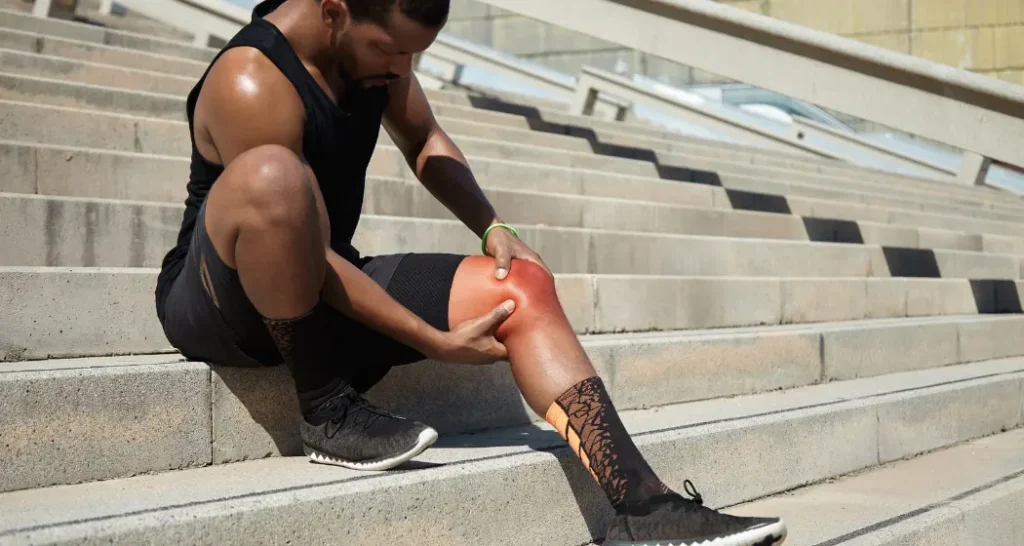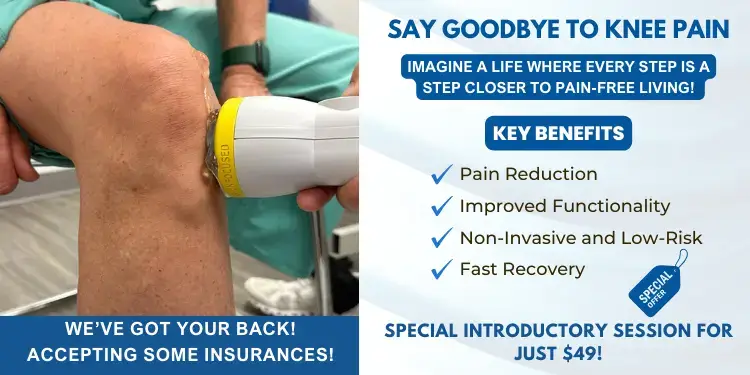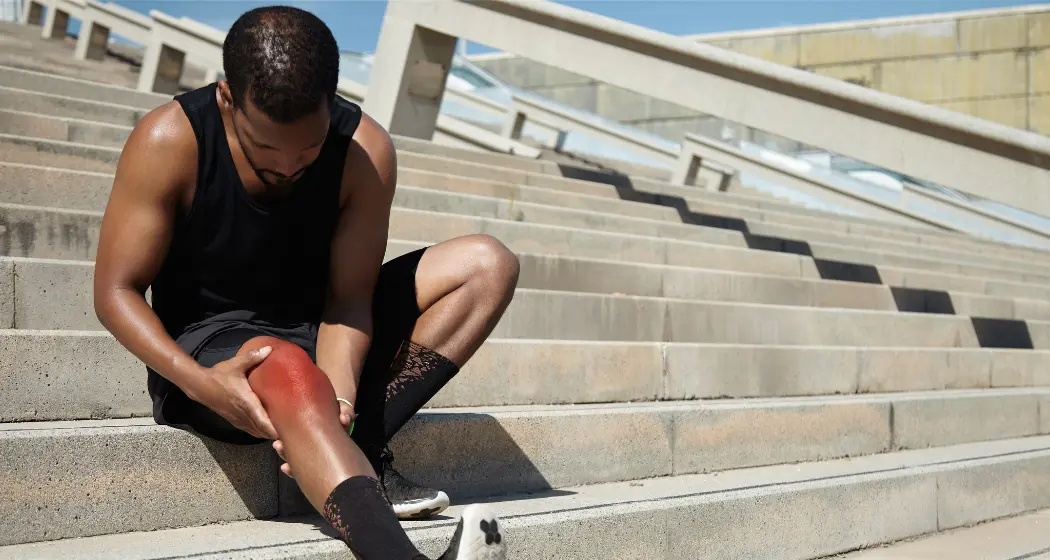
Are you feeling pain in your knee when you bend your knee or walk up and down steps? You’re not alone. Many people experience knee pain in these situations. If you have knee pain, you might be wondering which doctor to see for help. There are specialists in knee pain who focus on treating knee pain, and urgent care for knee pain can provide the care you need. In this article, we’ll explore the reasons why you might have knee pain when going up and down steps, and we’ll discuss the treatments available from knee pain specialists. So, let’s take a closer look at what could be causing your discomfort and how you can find relief.
When you feel pain in your knees while climbing stairs, it might be because of different reasons. Two main ones are chondromalacia patella, which happens when you overuse your knees, and arthritis, which affects the joints. Sometimes, a ligament injury or a condition called patellofemoral pain syndrome can also make your knees hurt.
These problems can make simple tasks like climbing stairs difficult and can cause other issues too. In this article, we’ll explore each of these causes of knee pain when going up and down steps. We’ll talk about the symptoms they bring, who is more likely to experience them, and how doctors find and treat them. Additionally, we’ll discuss the importance of understanding how bending your knees and walking can affect knee pain and what steps you can take to find relief.
Runner’s knee, or chondromalacia patella
Runner’s knee, or chondromalacia patella, happens when the smooth cartilage at the back of your kneecap starts to get soft and wear down. Normally, your kneecap slides smoothly as your knee bends and straightens. But when this cartilage breaks down, it can cause rubbing and irritation in your knee joint.
Symptoms
A key sign of chondromalacia patella is a dull, achy pain around the back of your kneecap. You might also feel soreness below, inside, or outside your kneecap.
Many people with this condition feel sore when they do certain activities, like:
- Pain behind or around the kneecap, especially when bending the knee.
- Pain worsens when walking downstairs or downhill.
- Grinding or popping sensations in the knee.
- Swelling around the knee joint.
- Weakness or instability in the knee.
- Difficulty kneeling or squatting.
- Increased discomfort after prolonged sitting with bent knees.
Causes and Risk Factors
Certain things can increase your chances of getting chondromalacia patella. People who do endurance sports like running or biking often get chondromalacia patella more. When your muscles are out of balance, your kneecap may not move right in its groove, causing rubbing and irritation again and again.
Causes:
- Doing something too much, like running, jumping, or squatting a lot, can make your knee hurt from being used too often.
- Misalignment of the kneecap, leading to abnormal rubbing against the thigh bone.
- Muscles around your knee that aren’t strong or balanced enough, which can affect the way the kneecap moves.
Risk Factors:
- Playing sports or doing things that make your knees move a lot, like running, biking, or skiing.
- Muscle weakness or tightness in the legs, particularly the quadriceps and hamstrings.
- Previous knee injuries or surgeries.
- Things about your body, like having flat feet or very high arches, can change how your knee lines up.
- Being overweight or obese, which increases the stress on the knee joint during physical activities.
Recognizing the causes and risk factors, like repetitive knee stress, can guide individuals in taking preventive steps. If symptoms arise, seeking prompt evaluation at urgent care for knee pain ensures timely treatment for conditions like chondromalacia patella
Arthritis
When the cartilage wears away, there’s less space between the bones in the knee (like the tibia, fibula, and patella) gets smaller. This can lead to damage to one or more of these bones, which is called arthritis.
The most common type of arthritis linked to this is osteoarthritis (OA). It’s a kind of arthritis where the joint wears out over time.
Symptoms of Arthritis
Both chondromalacia patella and arthritis can cause a lot of pain when you climb stairs, walk, or squat. But there are ways to tell them apart. For example, with chondromalacia patella, you might feel more pain when bending your knee, while arthritis can cause joint swelling and stiffness that lasts longer. It’s important to pay attention to these additional symptoms to get the right treatment.
- Joint pain, stiffness, or tenderness, especially after resting.
- Swelling and inflammation around the affected joint.
- Difficulty moving the joint or performing daily activities.
- Joint warmth and redness.
- Grinding or popping sensations when moving the joint.
- The affected joint can’t move as much as it used to
- Fatigue or general feeling of unwellness.
These symptoms of knee pain can be unpredictable, ranging in severity and occurrence. Seeking guidance from specialists in knee pain ensures the doctor knows exactly what’s wrong and finds the best ways to help you feel better.
Who gets arthritis?
Arthritis can happen to anyone, no matter their age, gender, or background. While it’s more common in older adults, young people and children can also develop arthritis. Factors like genetics, lifestyle, obesity and environmental influences can play a role in who develops arthritis.
Additionally, certain occupations or activities that put repetitive stress on the joints may increase the risk of developing arthritis. Knowing these things can help people do things to lower their chances of getting it and handle it well if they do.
Ways to develop arthritis include:
- Age: As people get older, they’re more likely to get arthritis.
- Genetics: Family history can play a role in the development of arthritis.
- Joint injuries: Previous injuries to the joints, such as fractures or dislocations, can increase the likelihood of developing arthritis later in life.
- Overuse or repetitive stress: Jobs or activities that involve repetitive movements or put stress on the joints, such as lifting heavy objects or playing certain sports, can contribute to the development of arthritis.
- Obesity: If you’re too heavy, it can make your joints work harder and make you more likely to get arthritis.
- Infections: Some infections like Lyme disease or infections you can get through sex can sometimes cause arthritis.
- Autoimmune diseases: These deceases such as rheumatoid arthritis and lupus can make your joints pain and feel stiff, where the immune system fights against the body, can lead to arthritis.
Understanding these risk factors empowers individuals to take preventive steps and make lifestyle adjustments to lower arthritis risk. For those experiencing symptoms, seeking evaluation from specialists in knee pain or visiting urgent care for knee pain ensures timely intervention and appropriate management strategies.
Ligament Injuries
Ligament injuries occur when the tough bands of tissue that connect bones together are stretched or torn. These injuries can happen in various parts of the body, including the knees, ankles, wrists, and shoulders. Common causes of ligament injuries include sudden twists or impacts, overextension of joints, and repetitive stress on the ligaments.
Symptoms of a ligament injury may include pain, swelling, bruising, instability in the affected joint, and difficulty moving the joint normally. Treatment for ligament injuries often involves rest, ice, compression, and elevation (RICE), also, doing exercises with a therapist to make the sore part stronger and move better.
In severe instances, surgery might be needed to fix a damaged ligament. Consulting specialists in knee pain is crucial if you suspect a ligament injury to prevent worsening and promote effective healing. Urgent care for knee pain can provide timely evaluation and necessary interventions.
Why Ligament Injuries Occur
Ligament injuries occur for various reasons. Some common causes include:
- Sports or physical activities: Participating in sports that involve sudden stops, changes in direction, or impacts, such as soccer, basketball, or skiing, can put stress on the ligaments and lead to injury.
- Accidents: Falls, collisions, or other accidents can cause sudden twists or impacts that overstress the ligaments, resulting in injury.
- Overuse or repetitive strain: Engaging in repetitive movements or activities that place constant strain on the ligaments, such as repetitive lifting or running, can gradually weaken the ligaments and make them more prone to injury over time.
- Improper technique or form: Performing movements incorrectly, such as landing from a jump with poor technique or lifting weights with improper form, can increase the risk of ligament injury.
- Weak muscles or imbalances: Weakness or imbalances in the muscles surrounding a joint can place extra stress on the ligaments, making them more susceptible to injury.
- Aging: As people age, the ligaments can become less elastic and more prone to injury.
Ligament injuries can also result from sudden impacts, such as those experienced during a car accident. The force generated during a collision can overstress the ligaments, leading to stretching or tearing. It’s important to wear seat belts and use proper safety equipment while driving or participating in activities with a risk of impact to help prevent ligament injuries in such situations.
Diagnosis
Diagnosing knee pain typically involves a combination of medical history, physical examination, and diagnostic tests. When talking about your health history, the doctor will ask about when the pain started, where it hurts, how long it lasts, and how bad it is. They’ll also ask about things that make it worse or better.
During a checkup, the doctor may see how well your knee moves, how stable it is, and how strong it is. They’ll also check if it’s swollen, sore, or looks different than usual.
Diagnostic tests that may be used to aid in the diagnosis of knee pain include:
- X-rays: X-ray can show if there’s anything wrong with the bones in your knee, like fractures, or degenerative changes in the knee joint.
- MRI (magnetic resonance imaging): MRI scans show detailed images of the soft parts in your body, like ligaments and tendons, allowing for the detection of injuries or abnormalities that may not be visible on X-rays.
- CT scan (computed tomography): CT scans may be used to provide detailed images of the bones and surrounding structures in cases where more information is needed than what X-rays can provide.
- Ultrasound: Ultrasound imaging can check soft parts in your body like tendons and ligaments. They can show if there are any tears or swelling.
Once the doctor knows what’s wrong, they can talk to you about what to do next, which may include rest, ice, compression, elevation (RICE), physical therapy, medication, injections, or surgery, it depends on what’s causing the knee pain and how bad it is.
Treatment
For many knee injuries, simple treatments can help a lot, especially if the pain isn’t too bad. Here are some tips to ease the pain when you go up stairs:
- Rest: Not doing things that make the pain worse and letting your knee rest can help it get better.
- Ice: Putting ice packs to the affected area can help reduce swelling and alleviate pain. It’s typically recommended to apply ice for 15-20 minutes every few hours.
- Compression: Wrapping a bandage or putting on a knee brace can make your knee more steady and make swelling go down.
- Elevation: Elevating your leg higher than your heart can make swelling go down and help blood flow better to the sore spot.
- Physical therapy: A therapist can give you exercises and stretches to make the muscles around your knee stronger, help you move better, and make your knee work better.
- Medication: Medicines you can buy without a prescription, such as ibuprofen or acetaminophen, can help with pain and swelling. Sometimes, the doctor might suggest stronger medicines or shots of corticosteroids.
- Regenerative medicine: these treatments can heal the affected area. Treatments can include platelet rich plasma therapy (PRP), amniotic tissue and even human cellular tissue like mesenchymal stem cells.
- Surgery: This should be a last resort and only In severe cases or if simple treatments don’t work, you might need surgery to fix things like torn ligaments or cartilage.
It’s important to consult from specialists in knee pain for an accurate diagnosis and personalized treatment plan tailored to your specific needs. Urgent care for knee pain offers timely evaluation and interventions for immediate relief. Additionally, changing your habits like staying a healthy weight, not doing things that make your knees hurt a lot, and wearing shoes that support your feet can stop knee pain and keep your joints healthy for a long time.
Prevention
You can prevent many reasons for knee pain when when going up and down steps by:
- Losing weight if you’re overweight or obese.
- Wearing kneepads if you often kneel.
- Choosing shoes that fit well and using arch supports.
- Keeping your leg muscles strong: Do exercises that make your hamstrings, quads, and abductors/adductors stronger. If you might get arthritis, pick activities that aren’t too hard on your joints. And use the right form.
- Warming up before you exercise and cooling down afterward.
Summary
Knee pain when going up and down steps is common and can have various causes. However, many cases can be managed with simple measures. Here are some tips to stop or prevent knee pain when going up and down steps before it happens.
- Maintain a healthy weight.
- Use kneepads if kneeling frequently.
- Choose well-fitting shoes and consider using arch supports.
- Keep leg muscles strong through exercises targeting hamstrings, quads, and abductors/adductors.
- If at risk for arthritis, opt for low-impact activities and ensure proper technique.
- Always stretch and warm up before you exercise, and then take it easy when you’re done.
Following these tips can help reduce knee pain and improve overall knee health while climbing stairs.
Feeling a twinge in your knee around St. Petersburg? No need to panic and dash to the ER! Just schedule a checkup with us instead. Our team at Waters Edge Medical Clinic here in St. Petersburg, Florida. Our pain Physicians is top-notch at handling knee discomfort. Save yourself the hassle and snag relief by booking online at www.watersedgemedicalclinic or ringing us up at 727-550-0855..
WE’RE OFFERING A SPECIAL INTRODUCTORY SESSION FOR JUST $49.
Unleash A New Era Of Pain Relief With Our Cutting-Edge Solution, Clinically Proven To Provide


